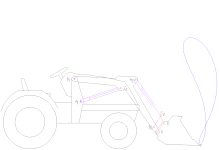Front loader (tractor)
A front loader is a movable rocker arm (arm of the wheel loader ) made of steel tubes that can be mounted on a tractor . Front loaders are used in agriculture or in the municipal sector, for lifting and moving loads (hay and straw bales, manure ...). A tractor with an attached front loader basically fulfills the function of a wheel loader.
service
Older front loaders are operated using separate levers for each function, i.e. one lever for lifting and lowering, one for filling and emptying the bucket and one for any additional functions. This required frequent changing of grip during work. Modern front loaders are controlled by joystick or cross lever, with movement back and forth raising and lowering the swing arm of the front loader and movement to the side tilting the bucket. Additional pressure and toggle switches control the additional functions. This means that up to three movements, for example tilting the shovel, lifting the rocker and closing the manure grabber, can be carried out at the same time.
Functions
Raise and lower
Lifting takes place via the tractor's own hydraulic pump , in which oil is pumped into two lifting cylinders. When lowering, the oil is usually displaced from the cylinder again by gravity. On models with double-acting lifting cylinders, lowering is also carried out with hydraulic pressure. These can transfer the weight of the tractor to the implement and lift the front axle into the air.
A gas damper in the hydraulic circuit of the lifting cylinder can dampen the mechanical disturbance of the swing arm caused by uneven floors.
Movement of the tool (types)
With simple front loaders (also clinker loaders ), the front loader tools (e.g. earth shovel ) are actuated from the vehicle by opening a latch with the aid of an electromagnet or a cable pull. However, this only enables the shovel to be emptied; however, scooping is not possible.
With so-called industrial front loaders, there is another pair of double-acting cylinders available for hydraulic device actuation. This newer design allows the driver to empty the shovel and pull it back up again from the cab using the hydraulics.
There are also variants with rapid traverse for quick dumping. A special valve does not displace the oil from the "tilting chamber" of the hydraulic cylinder into the hydraulic oil tank, as is usual, but instead feeds it into the "tilting chamber".
Additional hydraulic connections can be available for tool functions (gripping, rotating, cutting ...) or for tool locking. Depending on the manufacturer and equipment variant, up to four additional double-acting control units are available.
Tool assembly
Industrial front loaders often have a linkage (mostly Euro quick-change frames) to which the tool is attached with two hooks and two eyes. There is no need to mount the tilt cylinder on the tool. In combination with an automatic tool lock, the driver can change tools without having to get off the vehicle.
Attachments / tools
Standard tools are primarily pitchforks, shovels, pallet forks, forks with heavy-duty tines (round bale fork) or beet baskets.
Moving tools include a Siloschneidzange, crate rotary components or gripping tools for foil bales , manure , timber logs barren like.
Parallel guidance

With front loaders with parallel guidance, the angle between the implement and the ground hardly changes during lifting. A parallel guide makes it possible to use a pallet fork. Due to the rotating movement of the rocker, the pallet would tip backwards when it was lifted without parallel guidance. The parallel guide compensates for this by pushing the fork forwards or backwards accordingly through the parallelogram movement of the additional arms. It can be done mechanically (parallelogram) or hydraulically.
Requirements for the tractor
The tractor must have a hydraulic system that can be controlled from the driver's seat. The on-board control units (these are valves that regulate the oil flow for the individual functions) can be used for this.
If the tractor is not equipped with a sufficient number of hydraulic control units, the front-loading control blocks must divert the oil flow accordingly. These are mostly operated electromagnetically.
The electrical connection requires a 12 V power supply, which is passed on via pressure switches.
In addition, the tractor must have a so-called mounting bracket for the front loader. This consists of two mountings, which are located on the left and right in front of the cab on the tractor. These consoles are usually designed in such a way that the weight of the lifted loader is distributed as far as possible over the entire length of the tractor. Modern consoles are designed so that attaching and removing the loader only takes a few minutes. Front loader consoles are not yet standardized in such a way that different types can be mounted.
In general, it should be noted that front loaders can put considerable strain on the front axle of the tractor when they are used intensively.
Various recordings
without quick change frame
- mechanical / electrical Klinklader (sizes I - III)
with quick change frame
- EuroNorm
- SMS (Svensk Maskin Standard)
- Quicke type 3
- Euro / Type 3 combination quick-change frame
- Hauer recording



